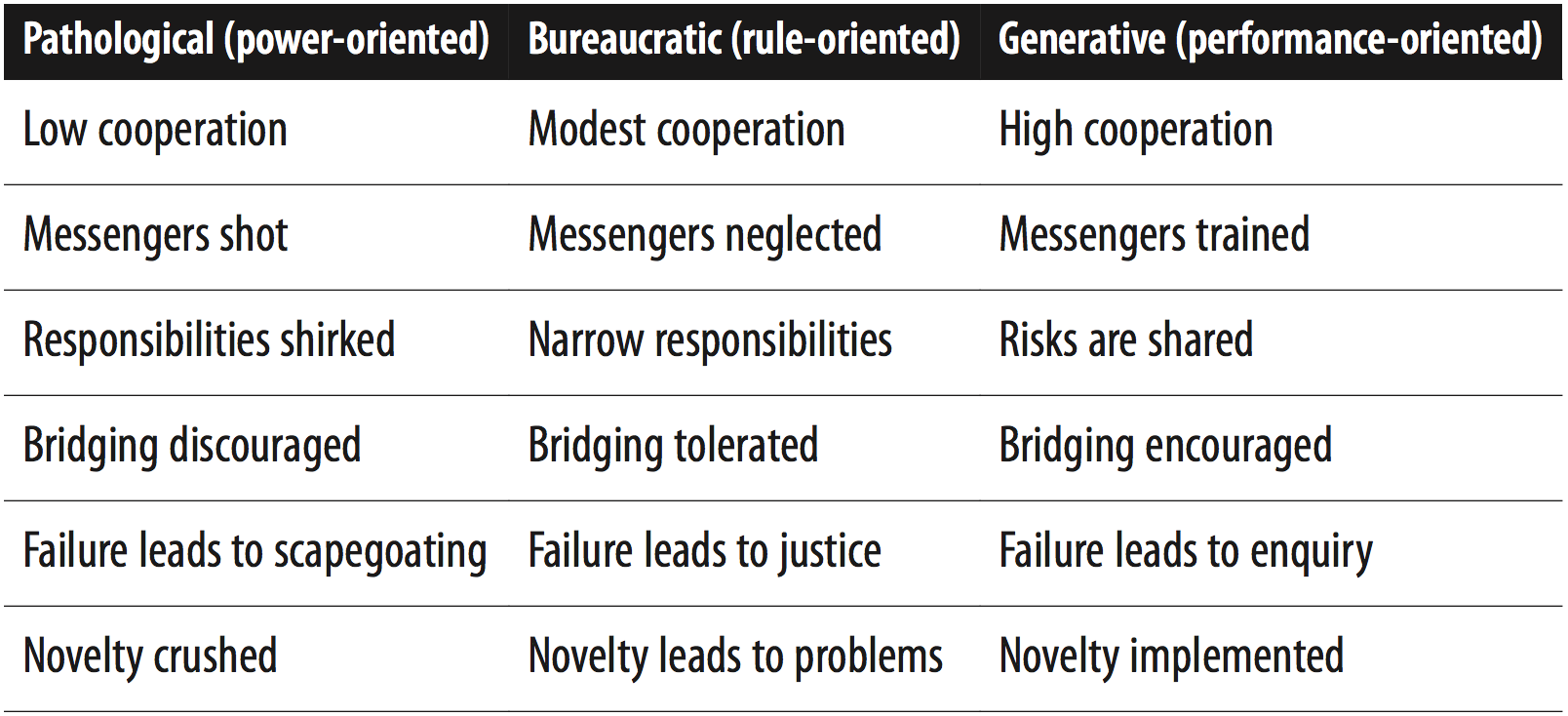Culture
Edgar Schein, author of The Corporate Culture Survival Guide, defines culture as “a pattern of shared tacit assumptions that was learned by a group as it solved its problems of external adaptation and internal integration, that has worked well enough to be considered valid and, therefore, to be taught to new members as the correct way to perceive, think, and feel in relation to those problems.”
Culture is intangible and hard to change, but it can be measured and it is of vital importance to your company’s bottom line. Research published in the 2014 State of DevOps Report shows that in the context of IT, job satisfaction is the biggest predictor of profitability, market share, and productivity. The biggest predictor of job satisfaction, in turn, is how effectively organizations process information, as determined by a model created by sociologist Ron Westrum, shown below:

Westrum’s research emphasizes the importance of creating a culture where new ideas are welcomed, people from across the organization collaborate in the pursuit of common goals, where we train people to bring bad news so we can act on it, and where failures and accidents are treated as opportunities to learn how to improve rather than witch-hunts.
The DevOps movement has always emphasized the primary importance of culture, with a particular focus on effective collaboration between development teams and IT operations teams. Research shows that a win-win relationship between development and ops is a significant predictor of IT performance. Practitioners in the DevOps movement have also used a number of tools to help organizations process information more effectively, such as chatops, blameless post-mortems, and comprehensive configuration management.
Indeed the highest-performing companies don’t wait for bad things to happen in order to learn how to improve, they create (controlled) accidents on a regular basis so as to learn more quickly than the competition. Netflix took this to a new level with their Simian Army, which is constantly breaking their infrastructure in order to continuously test the resilience of their systems.
The common theme that can be observed in high performing organizations is that they are always trying to get better. Rather than waiting for the environment to shift around them or comparing themselves against others, they treat themselves as the standard to beat.
Resources
- The “Lean” movement originated in a joint venture between Toyota and GM called NUMMI. The NUMMI story is fascinating for many reasons, and is covered excellently in this podcast from This American Life: NUMMI case study
- John Shook, one of the key players in the NUMMI story and the wider Lean movement, describes how Toyota took GM’s worst-performing workforce and used it to staff GM’s highest-performing plant in his award-winning article How to Change a Culture: Lessons From NUMMI
- Continuous improvement—the art and science of making problem-solving habitual—is the essence of growing a high performance culture. Mike Rother, another leader of the Lean movement, provides a wealth of free material to help you develop a scientific approach to innovation.
- Effective DevOps, by Jennifer Davis and Ryn Daniels, is an excellent book-length guide to the cultural aspects of DevOps.
- Watch me discuss how to build a high performance culture in the context of software product development in my 30m talk How to Fuck Up “Respect for People” & Really Piss Off your Employees.
- One of the most important cultural characteristics to cultivate in your organization is a growth mindset (as defined by Carol Dweck in her book Mindset). Linda Rising gives an excellent 1h talk on mindset in the context of software teams.